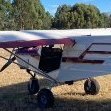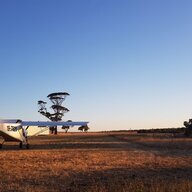-
Posts
6,669 -
Joined
-
Last visited
-
Days Won
100
About Kyle Communications
- Birthday 23/05/1959
Information
-
Aircraft
ICP Savannah VG XL/ S and Rans S21 Outbound
-
Location
Burpengary East
-
Country
Australia
Recent Profile Visitors
The recent visitors block is disabled and is not being shown to other users.
Kyle Communications's Achievements

Well-known member (3/3)
-
Kyle Communications started following Looking for Jabiru 4 and 6 cyc non working engine , 6 cylinder surprise , The Decibel Scale and 1 other
-
Actually warranty repair on anything there is NOT a requirement for the company to pay for the freight on your goods. The requirement is the company will totally fix/repair or replace the goods but the requirement is that you have to get it to them. This is the actual requirement by law here in OZ. If the manufacturer does offer to pay the freight for you to get it to them then thats a bonus. But the manufacturer will usually pay the freight back to you but you pay the freight to get it to them. That is how it was with our company when I was working for them. That was the government direction.
-
Jab 7252 we all know radios are pretty much all the same now internally but airband radios are "certified" that magic word for lots of paperwork crap that CASA and other govt depts seem to love. The issue of course is the Yaesu ham rigs and the other brands will toast the filters if used on the airbands with any sort of power if they have been modified to all band tx. Danny yes some radios are voltage sensitive and of course you should be using a good servicable battery.
-
Skippy ....Just spend the bucks and get a set of Lightspeeds...problem be gone 🙂
-
Aircraft produce the worst radio problems which can be very specific and hard to find. Just recently I was asked to look at a brand new Trig installation. I had a quick look and it sounded to me that the VCO was microphonic but I also said it could be the earthing or the wiring as it was done I believe at the factory. I didnt want to go any further as I have had enough of hanging upside down under dashes. It was sent to another place and I believe was basically rewired again and now the microphonics has gone. The V16 is a different design radio it is partially a digital radio a very different design. I have tested one on the bench...as I bought one and tried it as a bench receiver for about 6 months and it didnt miss a beat BUT some have had issues in setting them up correctly. There is a thread on the MGL forum that the designer explains how to actually setup the levels of the radio. You need to find it and then do what is said. This was not in the manual I got but I have told a few that I know who have them and they did the setup and apparently the radios are working fine
-
I am making a educated guess based on 30 plus years experience in the radio communications sales and repair industry. Having worked on the particular brand of that radio for almost as long as they have been around which by the way is getting close to that time line. I ALWAYS get a radio check before every flight. Usually while taxiing out to the strip during warmup. The radio box of bits is just electronics and they can and will fail. You usually only find out some time later after it fails when it becomes obvious there is a issue. The trees issue has always been there since the airfield was made. Discussions with the Council to remove them has been made many times over the 30+ years the airfield has been there but the club was not allowed to remove them as it is not on the lease of the airfield but it is still on the agenda to be rectified and is still being pursued. Hopefully this report may allow a bigger stick to be used to get it done. It was NOT the club stopping this. The dual runway issue as I said has been a long term bone of contention until this hit over the head with a big rock. This has been more firmly addressed since (read the current ERSA)... BUT even so there are still issues with dickheads and pilots who should not be pilots ( who also NEVER read the ERSA). In any club or association no matter what pursuit you do there is always about 5 or 10% of members who are either too stupid to comply or just dont give a rats arse about airmanship or courstesy or even safety. This is also trying to be addressed a lot more firmly but this also has issues of some people wishing to threaten certain types of legal action so its wonderful to sit back and be a opionator of how and what should be done but there are a lot more factors involved to actually get things done and make a difference. Human Factors has a whole new subject in it that is never spoken about but is very real.
-
David was a very experienced pilot. The big problem with the Microair is that when it fails and this is the most common failure mode I have seen with them is that they "appear" to be working perfectly but in actual fact they dont. They are working but not on the correct frequency. They head off around 148 mhz but they still transmit and receive. The only real way to confirm is ask for a radio check BEFORE takeoff or while running up then you can be reasonably sure its working. I am not sure the if the later versions of the radio this issue has been solved as I wont look at them anymore. The dual runway operation was always a bone of contention with quite a few of us at YCAB but thats another story that wont be discussed here
-

E-Props ...who has first hand experience with these
Kyle Communications replied to eightyknots's topic in Engines and Props
Eprop are doing special design work to complete their project for making their incredible propellors. They are doing 2 blade full carbon props for all aviation engines other than Rotax. Here is a email I got from Anne at Eprop who is the boss. Let me know if you have any parts that can be used for this scanning and I can organise getting them to France. The upshot would be a far better prop for your Jab and I am sure we could come with a special deal for anyone willing to help with getting these parts Hello Mark, Since you're from the land of Jabiru engines, let me ask you this. Do you know anyone who would give away out of order Jabiru 2.2 and 3.3 parts? What we are interested in : out of order crankshaft, connecting rod and piston. We'll pay for shipping from Australia to France, of course. In Europe, there are very few Jabiru engines. These parts can differ according to the models (and sub-models) of each type of engine, and these differences influence the resonances generated and the consequences on the propellers. The aim is to scan the parts and integrate this data into our LUKY software For the various Lycoming and Continental versions, we found parts in Europe. An Italian mechanic has offered us 3 engines just because he appreciates our work and research - which is cool ! Thank you ! -
Eprop are doing special design work to complete their project for making their incredible propellors. They are doing 2 blade full carbon props for all aviation engines other than Rotax. Here is a email I got from Anne at Eprop who is the boss. Let me know if you have any parts that can be used for this scanning and I can organise getting them to France. The upshot would be a far better prop for your Jab and I am sure we could come with a special deal for anyone willing to help with getting these parts Hello Mark, Since you're from the land of Jabiru engines, let me ask you this. Do you know anyone who would give away out of order Jabiru 2.2 and 3.3 parts? What we are interested in : out of order crankshaft, connecting rod and piston. We'll pay for shipping from Australia to France, of course. In Europe, there are very few Jabiru engines. These parts can differ according to the models (and sub-models) of each type of engine, and these differences influence the resonances generated and the consequences on the propellers. The aim is to scan the parts and integrate this data into our LUKY software For the various Lycoming and Continental versions, we found parts in Europe. An Italian mechanic has offered us 3 engines just because he appreciates our work and research - which is cool ! Thank you !
-
- 1
-

-

savvanah Savannah - manual vs electric flaps
Kyle Communications replied to petercoota's topic in Savannah
Max Tedesco from Columbia did a great job doing the 701 then of course he wanted to make some mods and Heintz didnt want them so Max then came up with the MX740 and ICP after been given the licence to build them essentially "commandeered" the design made a few little mods and called it the Savannah and the rest of course has been a success story for ICP- 33 replies
-
- 4
-

-

-

-
- manual flaps
- electric flaps
-
(and 1 more)
Tagged with:
-
I originally started flying in gliders back in the mid 1980's and was used to manual flaps and airbrakes of course but then went on to doing GA training in the early 1990's in Cessnas I am afraid I wasnt a fan of electric flaps. I much prefer manaul flaps.
- 33 replies
-
- 2
-

-

-
- manual flaps
- electric flaps
-
(and 1 more)
Tagged with:
-
My solution was as you see the 2 videos. The first was to change the stick position for mechanical advantage then I added another slot to give roughly 5deg then 15deg then the original 30deg of flap. I didnt modify anything other than just the 2 new side plates for the bracket. All the bushes and parts that move were all original. IBob's puts the stick a bit closer to the floor than mine. I sold about 50 sets of the brackets. I havent made anymore because the cost of getting the 1.6mm 6061 sheet from the 2 suppliers in Australia then freighted to Brisbane was getting crazy. I think that it would be fine though to use the 2024 T6 or even marine grade alu would be fine for the brackets. After some discussions with aircraft LAME and pro builders the 2024 would be well strong enough
- 33 replies
-
- 4
-

-

-
- manual flaps
- electric flaps
-
(and 1 more)
Tagged with:
-
The flap handle is too close to the seat when using full flap. Also there are only 2 setting on the std savannah for flap. I changed the geometry on mine by making a new bracket using the same parts just the angle so you can get the mechanical advantage back. I also added a extra flap position. I basically never used full flap on the sav as I think its too agressive, On mine I just mainly used the first and second stage and never used the third stage for full flap This is the updated with extra position
- 33 replies
-
- 5
-

-

-
- manual flaps
- electric flaps
-
(and 1 more)
Tagged with:
-

Kawasaki entering into aviation engine market
Kyle Communications replied to Kyle Communications's topic in Engines and Props
I dont think they ave done anything with the gearbox yet as in the scheme of things that for them is pretty simple. Get the engine specs and torque curves right first then the gearbox -

Kawasaki entering into aviation engine market
Kyle Communications replied to Kyle Communications's topic in Engines and Props
Well at the rate I am building my aircraft here it will probably be available by the time I am ready 😞






